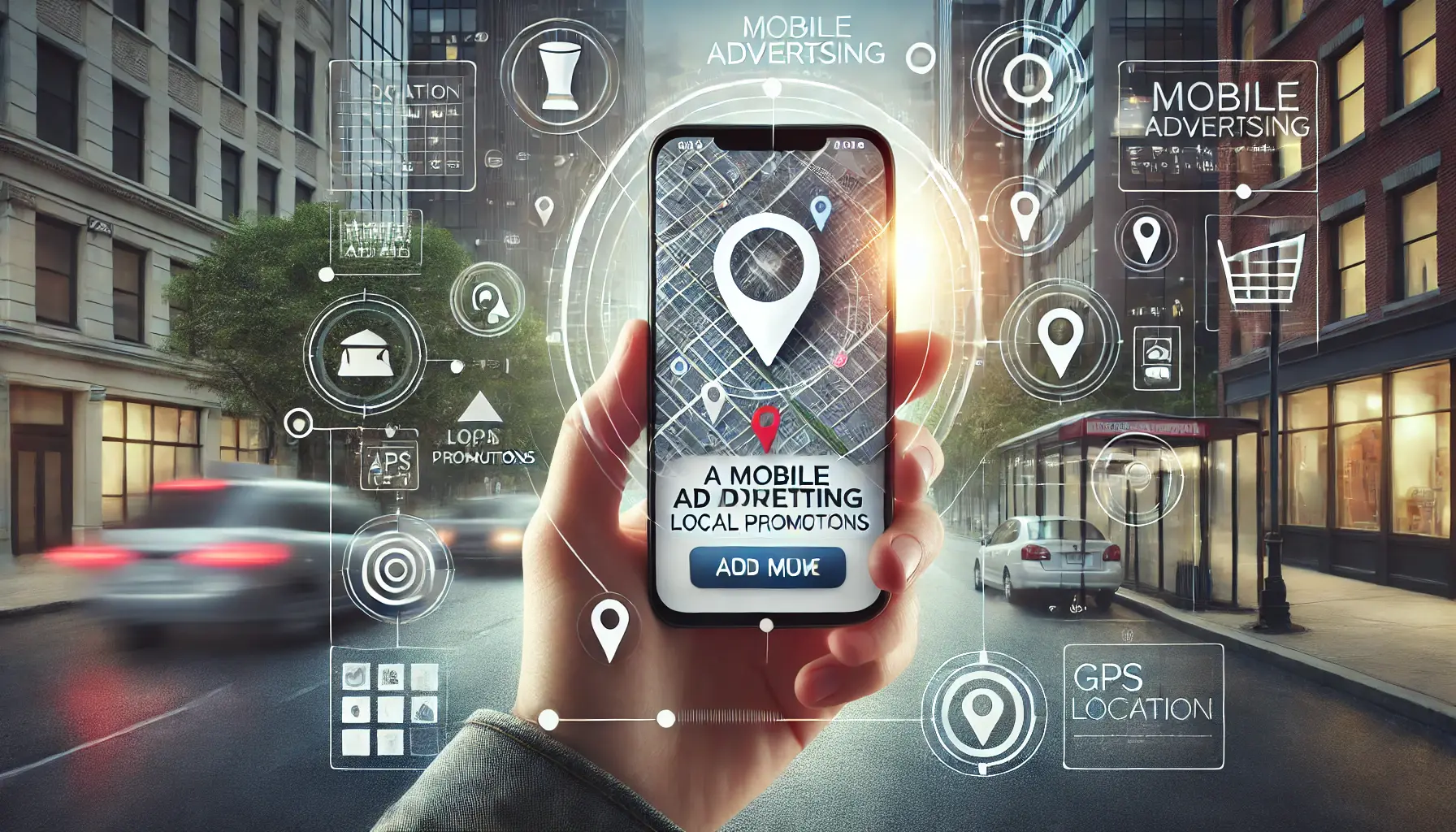During this digital age, mobile advertising is an indispensable tool for app developers and marketers.
With millions of apps contending for attention, effective promotion is no longer a nicety option but a necessity.
Mobile advertising is what links a great app with its target audience, while driving downloads and heightening user engagement.
If you’re looking to elevate your app’s visibility and attract more users, you are at the right place.
In this article, we’ll explore four powerful tactics to boost your app promotion, starting with an in-depth understanding of mobile advertising’s role.
- Understanding Mobile Advertising in App Promotion
- Tactic 1: App Store Optimization (ASO)
- Tactic 2: Leveraging Social Media Advertising
- Tactic 3: Implementing In-App Advertising Strategies
- Tactic 4: Utilizing Google Ads for App Promotion
- Conclusion: Mastering Mobile Advertising for App Success
- Frequently Asked Questions on Mobile Advertising for App Promotion
Understanding Mobile Advertising in App Promotion
Mobile advertising is the cornerstone of successful app promotion strategies.
It includes reaching prospective users on both smartphones and tablets using digital platforms.
Unlike traditional advertising, it gives unparalleled targeting capabilities to mobile advertising, allowing marketers to deliver personalized messages directly to their audience.
Let’s find out why mobile advertising is so essential and how it impacts your app’s growth.

A sleek representation of mobile advertising driving app growth through targeted strategies and interconnected networks.
The Role of Mobile Advertising in App Growth
Mobile advertising provides a way for applications to stand out from the crowd.
By placing ads strategically in those places where your target audience spends most of its time, you drive downloads and encourage user retention with brand loyalty.
Be it in-app ads, search ads, or social media campaigns, mobile advertising provides the right way to ensure that your app reaches its ideal users.
- Targeted: Mobile advertising platforms use data-driven insights to target users based on demographics, interests, and behavior.
- Effective Solutions: With options such as pay-per-click (PPC) and cost-per-install (CPI), you can control your budget while maximizing reach.
- Real-Time Engagement: Mobile ads enable one-step engagement—in the case of apps, downloading, and for other formats, signing up.
When done right, mobile advertising can turn an ordinary app into an indispensable utility in the user’s everyday life.
Understanding its impact on the growth of apps can lead to the creation of a winning strategy.

A professional depiction of key metrics used to gauge success in mobile advertising campaigns.
Key Metrics to Measure Success in Mobile Advertising
Tracking performance metrics is essential to ensure your mobile advertising efforts yield results.
Metrics such as click-through rate (CTRClick-Through Rate, the percentage of users who click on an ad after seeing it.), cost-per-acquisition (CPA), and return on investment (ROIReturn on Investment, a metric to measure the profitability of an advertising campaign.) provide valuable insights into what’s working and what needs improvement.
- Impressions: The total number of times your ad is displayed to users.
- Conversion Rate: The percentage of users who take the desired action, such as downloading your app.
- Retention Rate: The number of users who continue using your application over time.
By regularly checking on these metrics, you get to fine-tune your campaign and arrive at some conclusive points for sustainable app growth.
Mobile advertising is not just about placing ads; it’s about creating a trackable, involving relationship with your audience.
Mobile advertising serves as the bridge between app developers and their target audience, driving visibility and engagement in a competitive landscape.

A modern depiction of app store optimization tactics to enhance app visibility and performance.
Tactic 1: App Store Optimization (ASO)
App Store Optimization (ASOApp Store Optimization, a process of improving app visibility in app stores.) is a crucial strategy in mobile advertising, aiming to enhance your app’s visibility within app stores and increase organic downloads.
By optimizing various elements of your app’s store listing, you can attract more users and improve your app’s overall performance.

A detailed visual representation of optimizing app titles and descriptions for better app store performance.
Optimizing App Titles and Descriptions
Your app’s title and description are the first touchpoints a user will have with your application.
A clear, concise, and keyword-rich title helps in ranking higher in search results.
Similarly, a well-written description that highlights your app’s features and benefits can persuade users to download.
- Title: Include relevant keywords naturally without making the text unreadable.
- Short Description: Give a brief overview of the core functionality of your app.
- Long Description: Elaborate on features, benefits, and unique selling points, using bullet points for clarity.
According to App Radar, ASO involves optimizing textual components like app titles and descriptions with relevant and high-volume keywords, similar to SEO principles.

A modern depiction of the role of high-quality screenshots and videos in enhancing app store appeal.
Importance of High-Quality Screenshots and Videos
Visual elements are extremely important for user decision-making.
Screenshots and videos of high quality are great ways to showcase the interface and functionality of your app, providing users with an overview of what it will be like inside the app.
- Screenshots: Use images highlighting key features and that are visually appealing.
- Videos: Create short, engaging videos showing the app’s usability and benefits.
As noted by MobiLoud, using high-quality screenshots that stand out is essential for effective ASO.
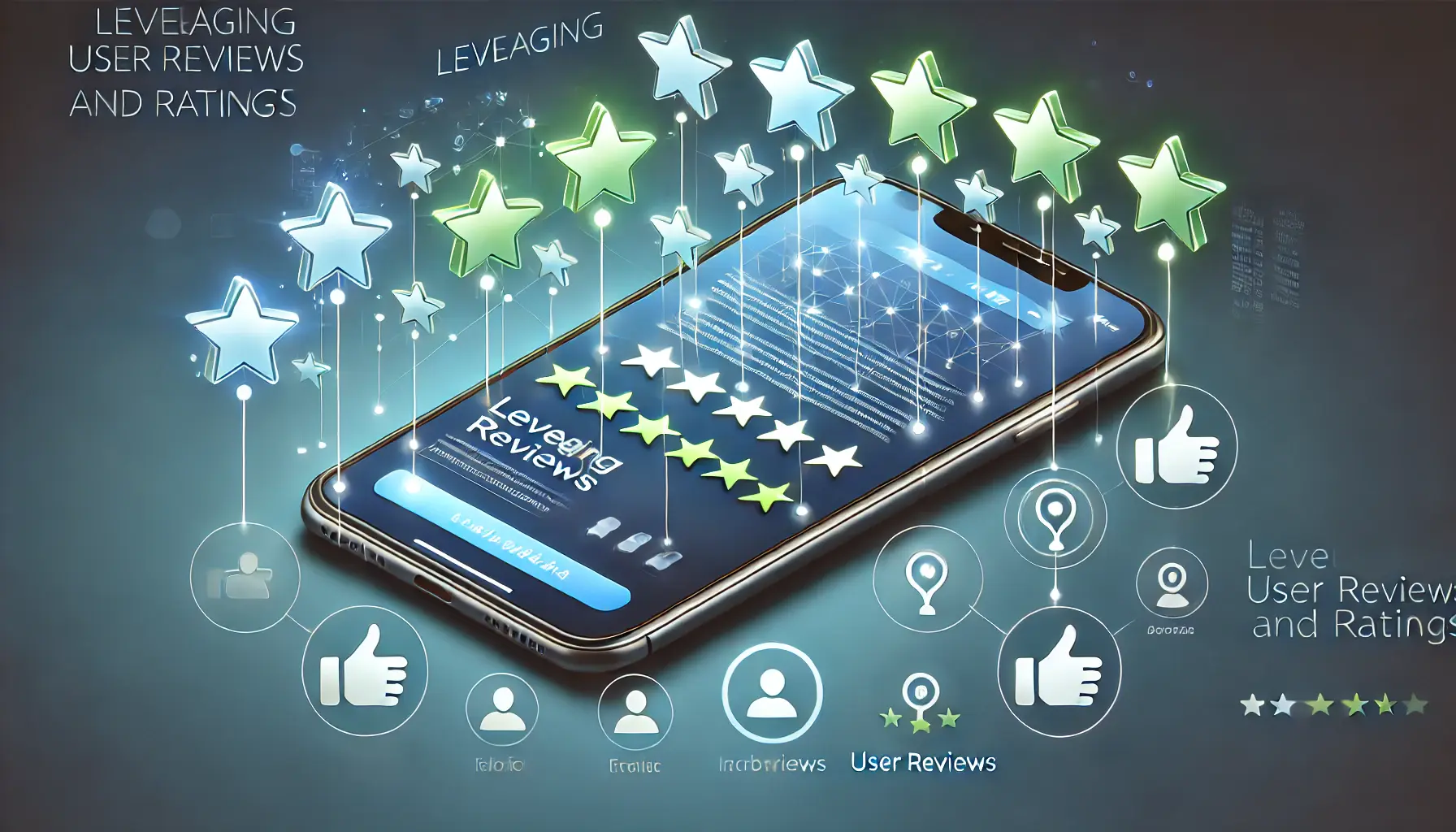
A depiction of the role of user reviews and ratings in building app credibility and user trust.
Leveraging User Reviews and Ratings
User reviews and ratings significantly impact your app’s credibility and visibility.
Encouraging satisfied users to leave positive feedback can enhance your app’s reputation and influence potential users.
- Prompt for Reviews: Implement in-app prompts at appropriate times to request user feedback.
- Respond to Feedback: Engage users by responding to reviews, addressing concerns, and showing appreciation.
- Monitor and Improve: Regularly read through reviews to identify areas for improvement and update your app accordingly.
According to App Radar, app store optimization is essential for all advertising channels since they will also benefit from improved conversion rates on an app’s product page.
By sticking to these ASO practices, the visibility and appeal of your apps can be remarkably improved, which in turn will drive more downloads and engage users.
App Store Optimization is essential for increasing your app’s visibility and organic downloads, ensuring long-term success in the app marketplace.
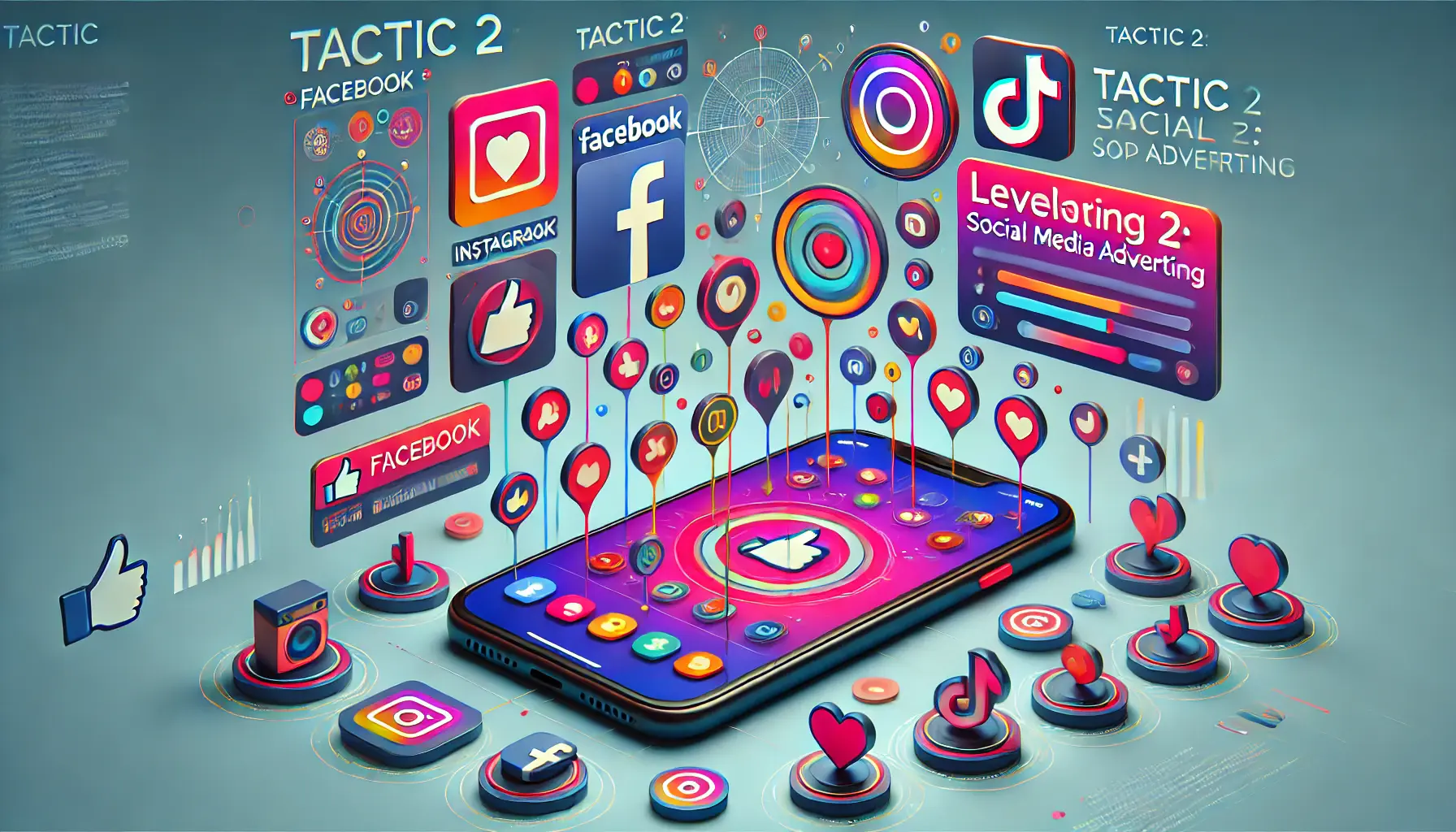
undefined
Tactic 2: Leveraging Social Media Advertising
In the realm of mobile advertising, social media platforms offer unparalleled opportunities to promote your app.
With billions of active users, platforms like Facebook, Instagram, and TikTok provide a vast audience base.
Effectively leveraging social media advertising can significantly boost your app’s visibility and user acquisition.

undefined
Targeting the Right Audience on Social Platforms
It is very important to identify and target your ideal user demographic.
Social media platforms come with advanced targeting options where you can reach users based on demographics, interests, behaviors, and even device usage.
This precision ensures that your ads are served to users who are most likely to engage with your app.
- Demographic Targeting: Pay close attention to age, gender, location, and language preferences.
- Interest-Based Targeting: Reach users who have shown interest in topics related to your app’s niche.
- Behavioral Targeting: Target users based on their online behaviors, such as app usage patterns.
According to Hootsuite, social media advertising uses paid ads on platforms like Facebook, Instagram, and LinkedIn to target specific audiences more effectively than organic posts.

A visual representation of creating engaging ad content to capture mobile users’ attention.
Creating Engaging Ad Content for Mobile Users
Crafting compelling ad content is essential to capture the attention of mobile users.
Utilize eye-catching visuals, concise messaging, and clear calls-to-action (CTAs) to encourage users to download your app.
- Visual Appeal: Use high-quality images or videos that showcase your app’s features.
- Concise Messaging: Deliver your message succinctly to accommodate short attention spans.
- Clear CTAs: Encourage immediate action with phrases like “Download Now” or “Try for Free.”
As noted by Buffer, social media advertising differs from influencer marketing; in social media advertising, you create and run ads from your brand account.

A visual representation of using influencer partnerships to promote an app through social media endorsements.
Utilizing Influencer Partnerships for App Promotion
Collaborating with influencers can amplify your app’s reach.
Influencers have established trust with their followers, and their endorsement can lead to increased downloads and user engagement.
- Identify Relevant Influencers: Choose influencers whose audience aligns with your target demographic.
- Authentic Promotion: Give influencers the freedom to create content that authentically reflects their experience with your app.
- Track Performance: Monitor referral download numbers and engagement rates to judge the effectiveness of the partnership.
Influencer Marketing Hub adds that influencer marketing platforms are software solutions that enable brands to discover, collaborate with, and manage social media influencers for content creation in their marketing campaigns.
By effectively leveraging social media advertising, you can increase your app’s visibility among targeted users and build higher engagement ratios.
Social media platforms like Facebook and Instagram provide unmatched targeting capabilities, making them indispensable tools for app promotion.
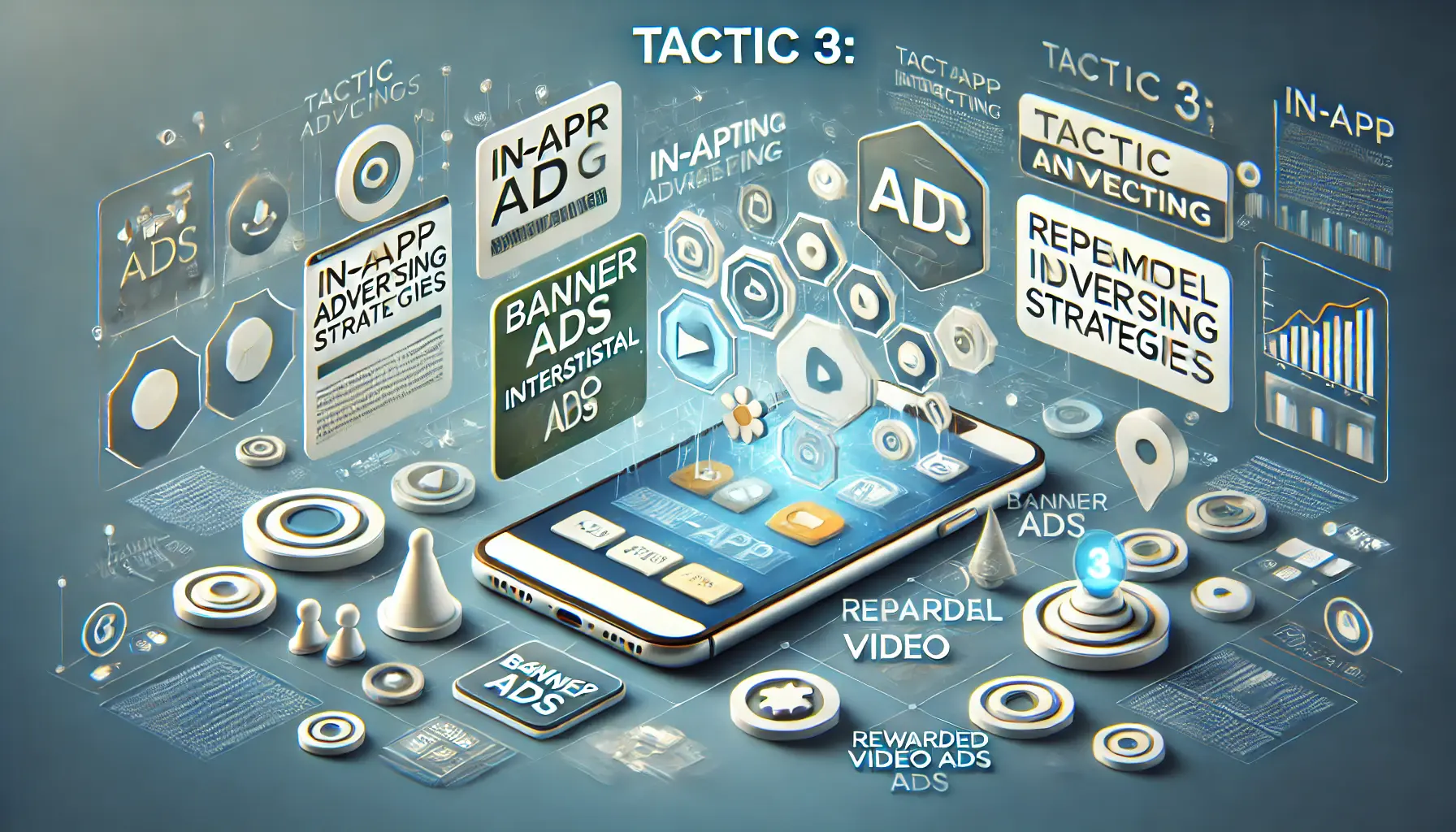
A visual representation of in-app advertising strategies, showcasing different ad formats and user engagement.
Tactic 3: Implementing In-App Advertising Strategies
In the competitive landscape of mobile advertising, implementing effective in-app advertising strategies is crucial for app promotion.
By integrating advertisements within your app, you can enhance user engagement and generate additional revenue streams.
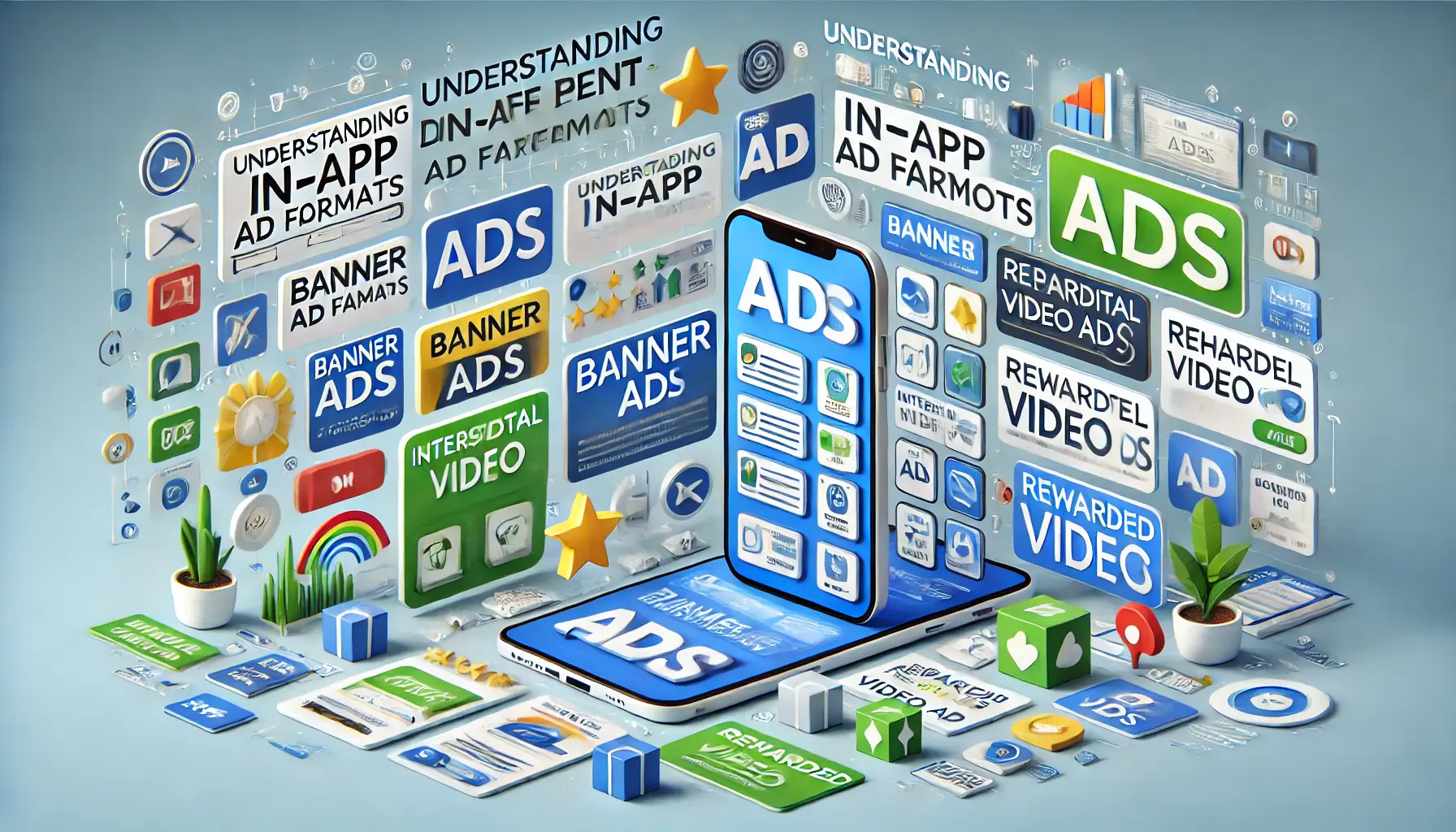
A visual representation of different in-app ad formats, showcasing the variety of ad types used in mobile apps.
Understanding Different In-App Ad Formats
Choosing the appropriate ad formats is essential to maintain a seamless user experience.
Common in-app ad formats include:
- Banner Ads: Appear either on the top or at the bottom of the screen; less intrusive and perfect for constant visibility.
- Interstitial Ads: Full-screen ads that appear during natural transition points, such as between levels in a game.
- Rewarded Video Ads: Provide rewards for users, such as in-game currency, in exchange for watching a video ad.
- Native Ads: Blend seamlessly with the app’s content, providing a non-disruptive advertising experience.
According to Adjust, rewarded video ads are particularly effective, with 53% of players stating they play a game longer because of receiving rewards through in-app ads.
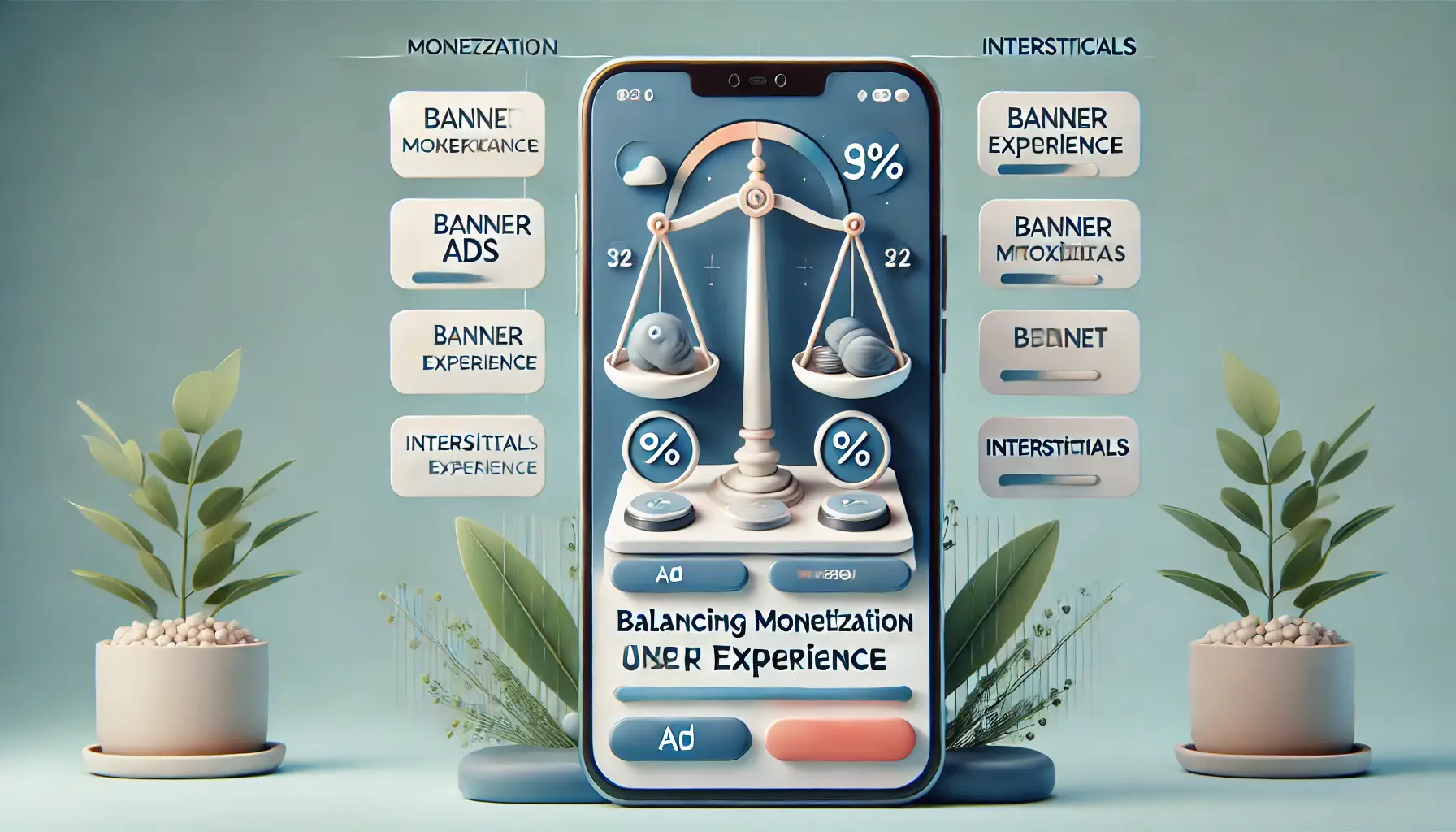
A visual representation of balancing monetization strategies with user experience in mobile apps.
Balancing Monetization and User Experience
While in-app ads can boost revenue, it’s vital to balance monetization efforts with user experience to prevent alienating your audience.
- Ad Placement: Place ads in non-intrusive positions that do not interfere with the user’s interaction with the app.
- Frequency Capping: Control the number of ad views by a user within a fixed time frame to avoid ad fatigue.
- Relevance: Ensure that the ads are relevant to your user base to keep them engaged and satisfied with your product.
As noted by Business of Apps, in-app advertising plays a significant role in the mobile app ecosystem as one of the most common methods for app monetization.

A visual representation of utilizing programmatic advertising to reach the right audience with precision and efficiency.
Utilizing Programmatic Advertising for Targeted Reach
Programmatic advertising leverages automated technology to purchase ad space, allowing for precise targeting and efficient ad spend.
- Real-Time Bidding (RTB): Enables the buying and selling of ad impressions through real-time auctions.
- Audience Segmentation: Targets user groups based on demographics, behaviors, and interests.
- Tracking Performance: Monitors ad performance with the aim of optimizing campaigns for maximum ROI.
As cited by AppsFlyer, better targeting aligns ads with the demographics and interests of app users, making in-app ads more likely to achieve results, with over double the click-through rate of mobile web ads.
Applying these in-app advertising methodologies will effectively market your app, engage your users, and provide sustainable growth within the competitive mobile advertising arena.
Effective in-app advertising strikes a balance between monetization and user experience, ensuring long-term user retention and engagement.
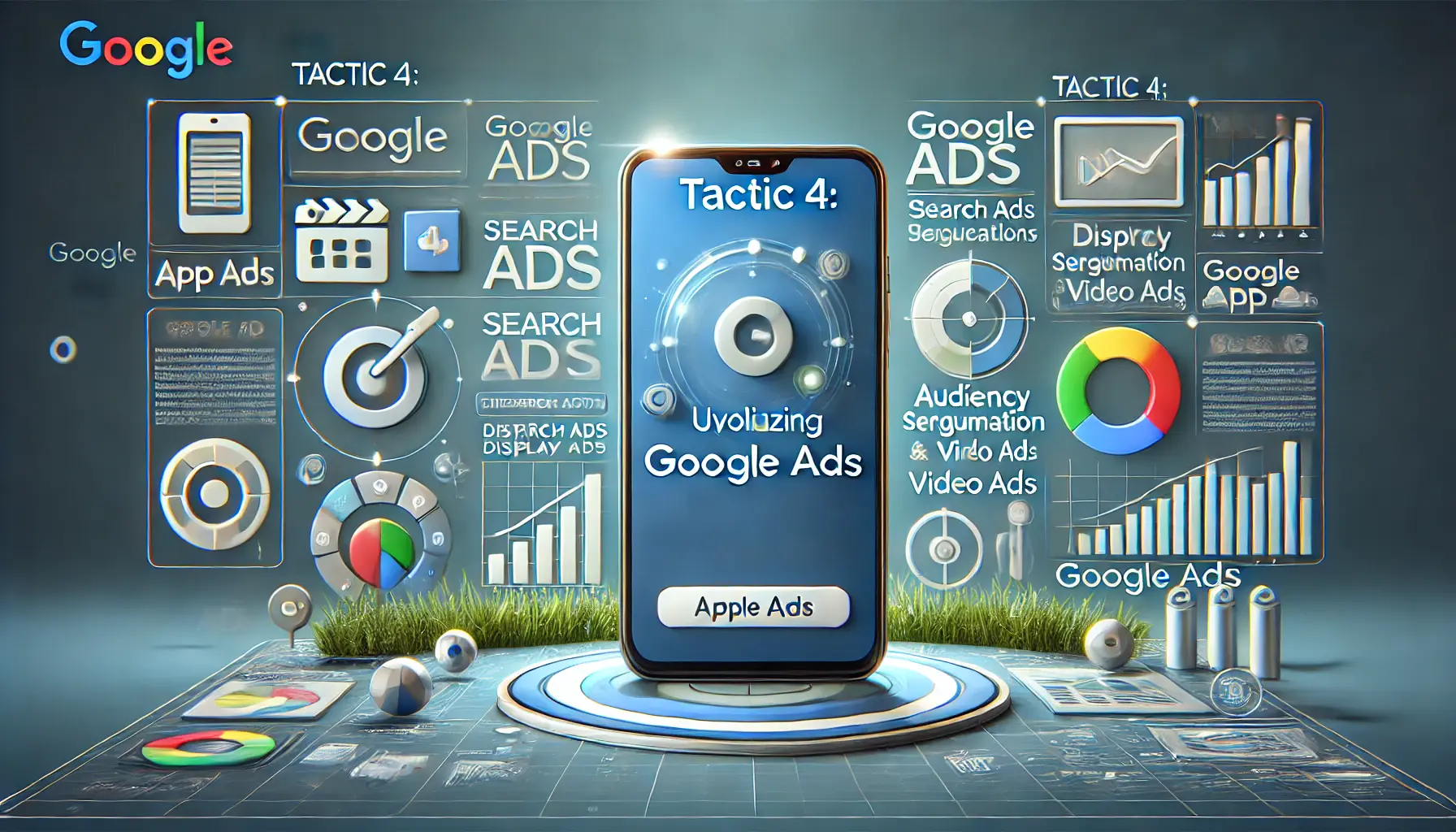
undefined
Tactic 4: Utilizing Google Ads for App Promotion
In the realm of mobile advertising, Google Ads stands out as a powerful platform for app promotion.
Leveraging its extensive reach and advanced targeting capabilities can significantly enhance your app’s visibility and user acquisition.
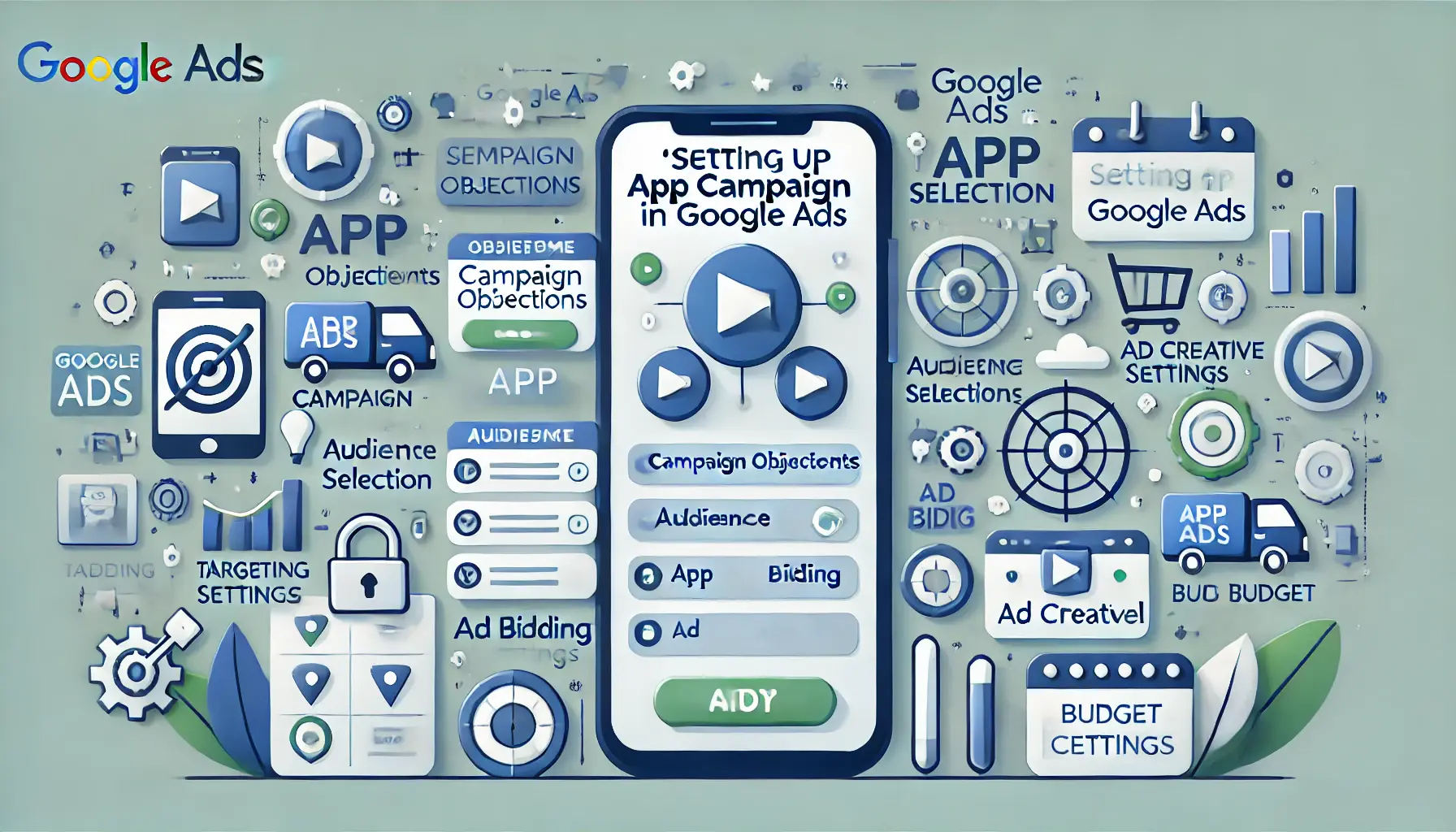
undefined
Setting Up App Campaigns in Google Ads
Google Ads offers specific App campaigns to make your app visible on Google’s enormous network, including Search, Play, YouTube, and the Display Network.
To create an App campaign in Google Ads:
- Select Campaign Objective: Choose ‘App promotion’ to focus on driving app installs or in-app actions.
- Define Your Audience: Leverage Google’s targeting options to reach users based on demographics, interests, and behaviors.
- Determine Budget and Bids: Identify your daily budget along with the bidding strategy of your choice, such as Target CPA or Maximize Conversions.
- Create Ad Assets: Provide text, images, and videos highlighting your app’s features and benefits.
According to Google Ads Help, App campaigns use machine learning to optimize your ads across Google’s properties.
This helps you find users most likely to install your app and further engage with it.
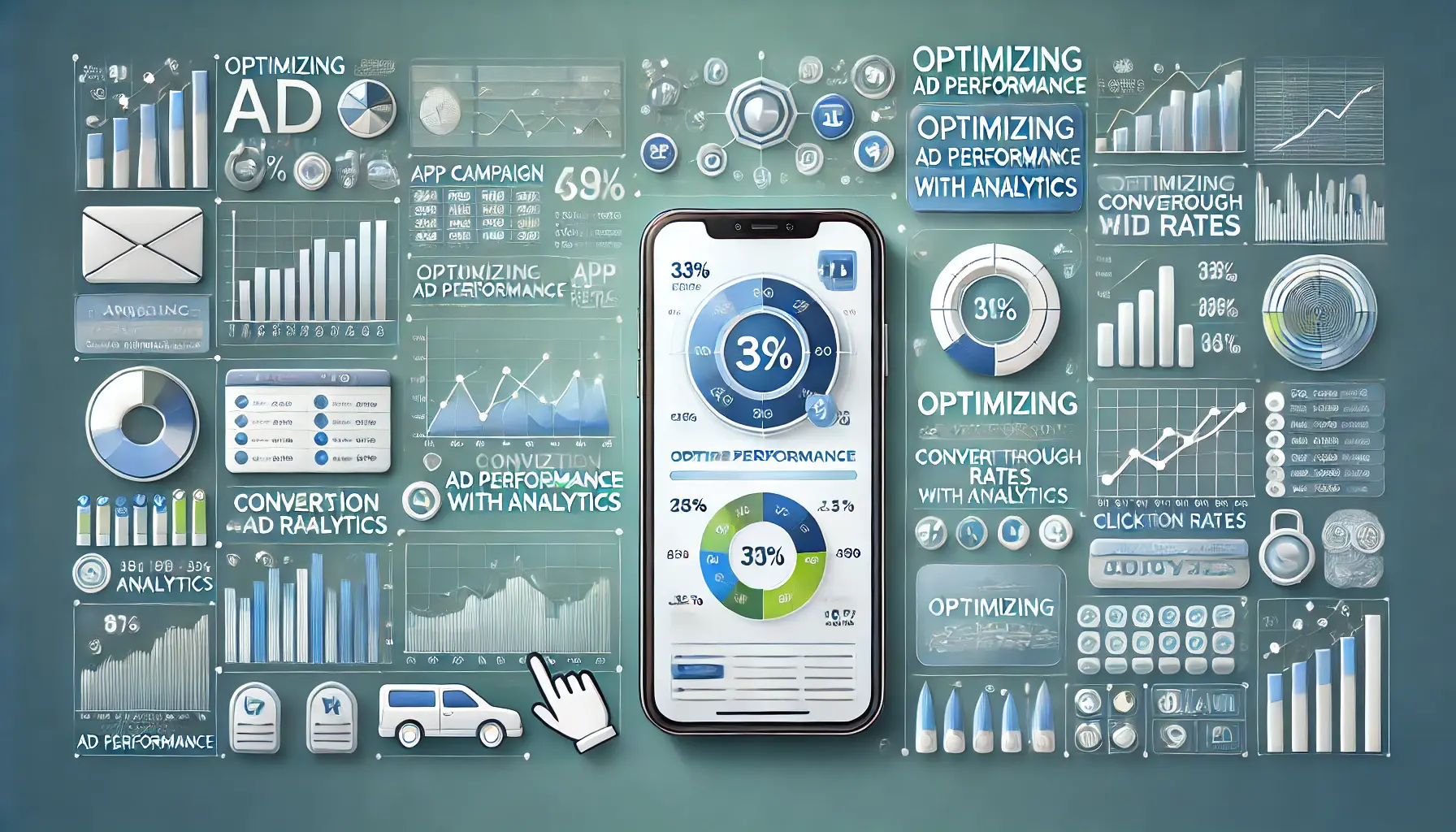
A visual representation of optimizing ad performance using analytics to track and refine campaign strategies.
Optimizing Ad Performance with Analytics
Monitoring and analyzing your campaign performance is crucial for continuous improvement.
Key metrics to track include:
- Install Volume: The number of app installs generated by your ads.
- Cost Per Install (CPI): The average cost incurred for each app install.
- In-App Actions: User activities within the app post-installation, such as purchases or sign-ups.
Utilizing tools like Google Analytics for FirebaseA platform developed by Google for creating mobile and web applications. can provide deeper insights into user behavior and help refine your advertising strategies.

A visual representation of leveraging advanced targeting and bidding strategies for optimizing ad campaigns.
Leveraging Advanced Targeting and Bidding Strategies
Google Ads provides advanced targeting and bidding options to maximize your campaign’s effectiveness:
- Target CPA Bidding: Focuses on acquiring users who are likely to perform valuable in-app actions at a specified cost per action.
- Target ROAS Bidding: Aims to achieve a specific return on ad spend by targeting users likely to generate higher revenue.
- Custom Audiences: Create audiences based on user behavior, app usage, or other criteria to effectively tailor your ads.
According to Google Ads Help, selecting the right bid strategy in your App campaign is crucial to match your marketing objectives for better results.
More recently, Google Ads for app promotion can effectively put you in front of more users, increase valuable engagement, and maintain sustainable growth in such a competitive mobile advertising landscape.
Google Ads offers a powerful platform for app promotion with advanced targeting and machine learning optimization, ensuring effective results.

A visual representation of mastering mobile advertising for app success, showcasing various marketing tools and success indicators.
Conclusion: Mastering Mobile Advertising for App Success

A visual representation of harnessing the power of mobile advertising, featuring app icons, targeted user symbols, and growth indicators.
Harnessing the Power of Mobile Advertising
Mobile advertising has proven to be an indispensable strategy in promoting apps effectively.
By implementing the tactics discussed in this article, developers and marketers can bridge the gap between their app and its target audience, driving visibility, engagement, and growth.
Each tactic offers unique benefits, making them essential components of a comprehensive app promotion strategy.

A visual representation of key takeaways from the article, highlighting important concepts like marketing strategies, mobile ads, and growth.
Key Takeaways from the Article
- App Store Optimization (ASO): Optimizing your app’s title, description, and visual elements enhances visibility within app stores and drives organic downloads.
- Social Media Advertising: Platforms like Facebook and Instagram offer precise targeting and the opportunity to connect with users through engaging content and influencer collaborations.
- In-App Advertising: Leveraging ad formats such as banner ads, interstitials, and rewarded videos can balance monetization and user experience effectively.
- Google Ads Campaigns: Utilizing Google Ads’ advanced targeting and bidding strategies ensures your app reaches the right audience, maximizing installs and in-app engagement.

A visual representation of final thoughts on mobile advertising, highlighting aspects like app marketing, optimization, and growth.
Final Thoughts on Mobile Advertising
Mastering the art of mobile advertising requires a holistic approach, combining creativity with data-driven strategies.
Promoting your apps in today’s competitive market can be achieved through platforms like Google Ads and social media, optimizing your app store presence, and utilizing in-app ad formats.
Remember, the secret to success lies in regularly monitoring your campaign performance and adjusting your strategies to meet ever-changing user behaviors.
When done correctly, mobile advertising does more than just increase app downloads; it builds a strong connection with your target audience, paving the way for long-term success.
By leveraging tactics like ASO, social media advertising, and Google Ads, you can create a comprehensive strategy that ensures your app’s success.
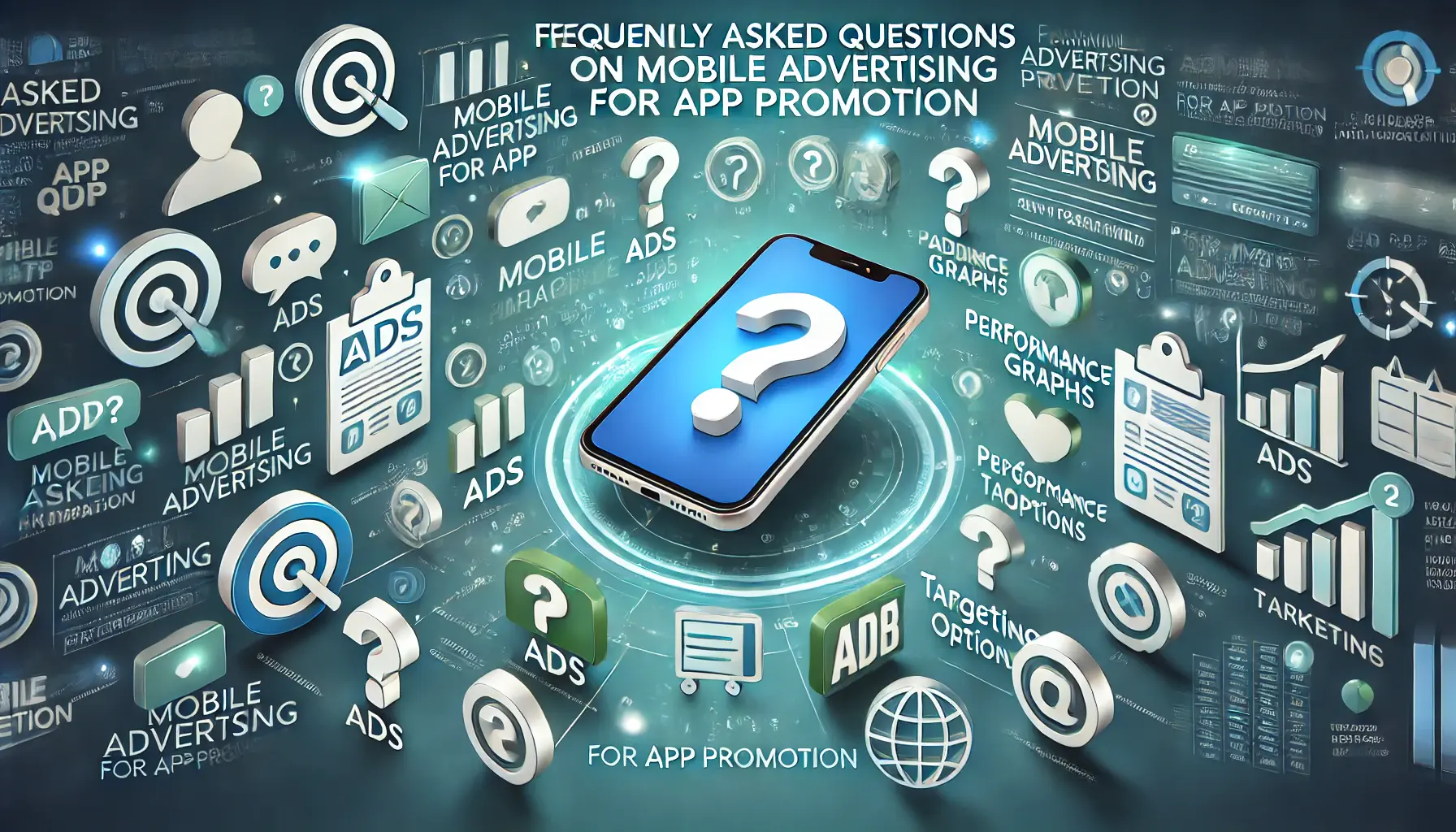
A visual representation of common inquiries and strategies for mobile advertising in app promotion.
Your campaigns can be managed by an agency specialized in Google Ads, check out our service page.
Frequently Asked Questions on Mobile Advertising for App Promotion
Mobile advertising is a dynamic field with numerous strategies to enhance app visibility and user engagement.
Below are some common questions and concise answers to guide you in effectively promoting your app through mobile advertising.
Mobile advertising involves promoting apps through ads displayed on mobile devices, aiming to increase app visibility, downloads, and user engagement.
ASO improves app visibility by optimizing elements like titles, descriptions, and visuals, making the app more discoverable in app store searches.
Social media advertising allows precise targeting and engagement with potential users through platforms they frequently use, boosting app awareness and downloads.
In-app advertising generates revenue and enhances user engagement by integrating ads seamlessly within the app experience.
Google Ads offers app campaigns that promote your app across Google’s vast network, reaching potential users effectively.
Key metrics include click-through rate (CTR), cost per install (CPICost Per Install, the cost incurred for each app installation through advertising.), and user retention rates, providing insights into campaign effectiveness.
Collaborating with influencers expands your app’s reach to their followers, leveraging established trust to encourage downloads.
Programmatic advertising automates ad buying, allowing precise targeting and efficient budget use, enhancing app promotion efforts.
Positive user reviews enhance app credibility and visibility, influencing potential users to download the app.


